The Apparition of Our Lady at Knock
August 21, 1879, Knock, Ireland
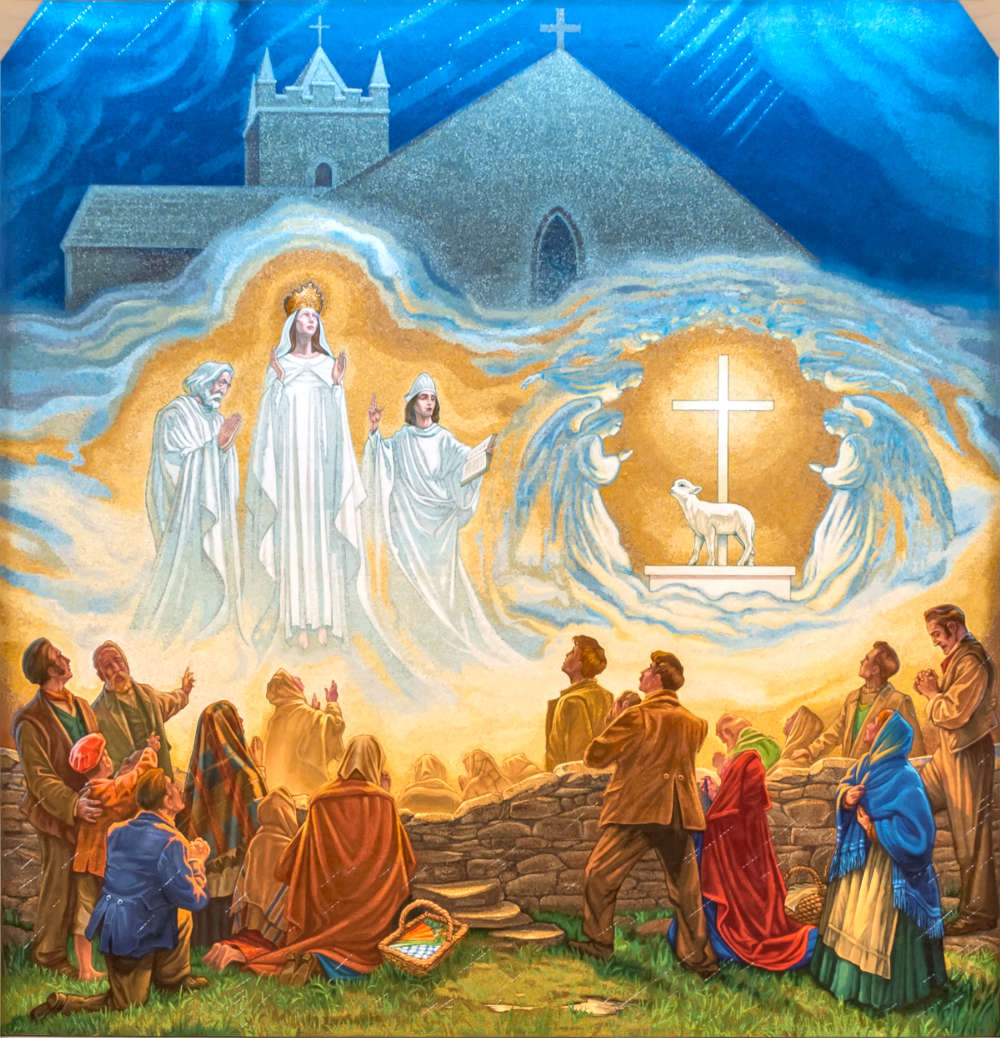
The humble people of the Knock of 1879, hidden away here in the West of Ireland, could not possibly have foreseen the climax of that day in August, when throughout the day the very elements seemed to be at war. Tradition has it that Knock had been blessed by St. Patrick, that he had prophesied that one day it would be a holy place, but the people were scarcely thinking of that as they looked out at the rains that beat furiously down upon their little village of a dozen houses. Towards evening a little girl of the village, accompanying the priest's housekeeper home, stopped suddenly as she came in sight of the gable of the little church. She must have rubbed her eyes in astonishment at what she saw. For there, standing a little out from the gable, were three life-size figures. Her spontaneous exclamation at the sight is significant. "Oh, look," said she, "they are moving." Movement is a sign of life. It was living beings she was gazing at, living beings with a presence, and that is the significance of her next gesture. She ran home to her mother, her family, that they might see what she saw, and verify her vision. The priest's housekeeper, who remained, suddenly remembered something. She had passed this way a little while ago when going to her neighbors. She had seen what she took to be statues: she had not taken much notice of them. But these were no statues-that moved and that had a presence.
It is not difficult to imagine the scene at the house of the Beirnes when the young girl returned so unexpectedly. She was breathless and excited. She told them of what had happened. The mother listened; her brother was skeptical. But when the girl dashed out again, as quickly as she had entered, the brother asked the mother to follow her; something was the matter; of this he was certain, because, despite his original attitude to the news, he followed in a moment. So convinced was he, on arrival at the scene, that he became the messenger who brought others. Soon there was a little knot of people, fourteen in all, standing or kneeling in front of the gable, and gazing at the Apparition. The night was very wet. The rain was still beating angrily down; the wind was sending it in driving sheets against the gable of the church. It was as if the very elements would obliterate, extinguish, the light that emanated from the object of their gaze. But the Apparition showed no sign of disappearing. It was immune to the attack of wind and rain and storm. It did not extend protection to the onlookers, one of whom described his condition as that of being drenched, but the gable of the church and the ground beneath the vision was dry, dry as if not a drop of rain was falling.
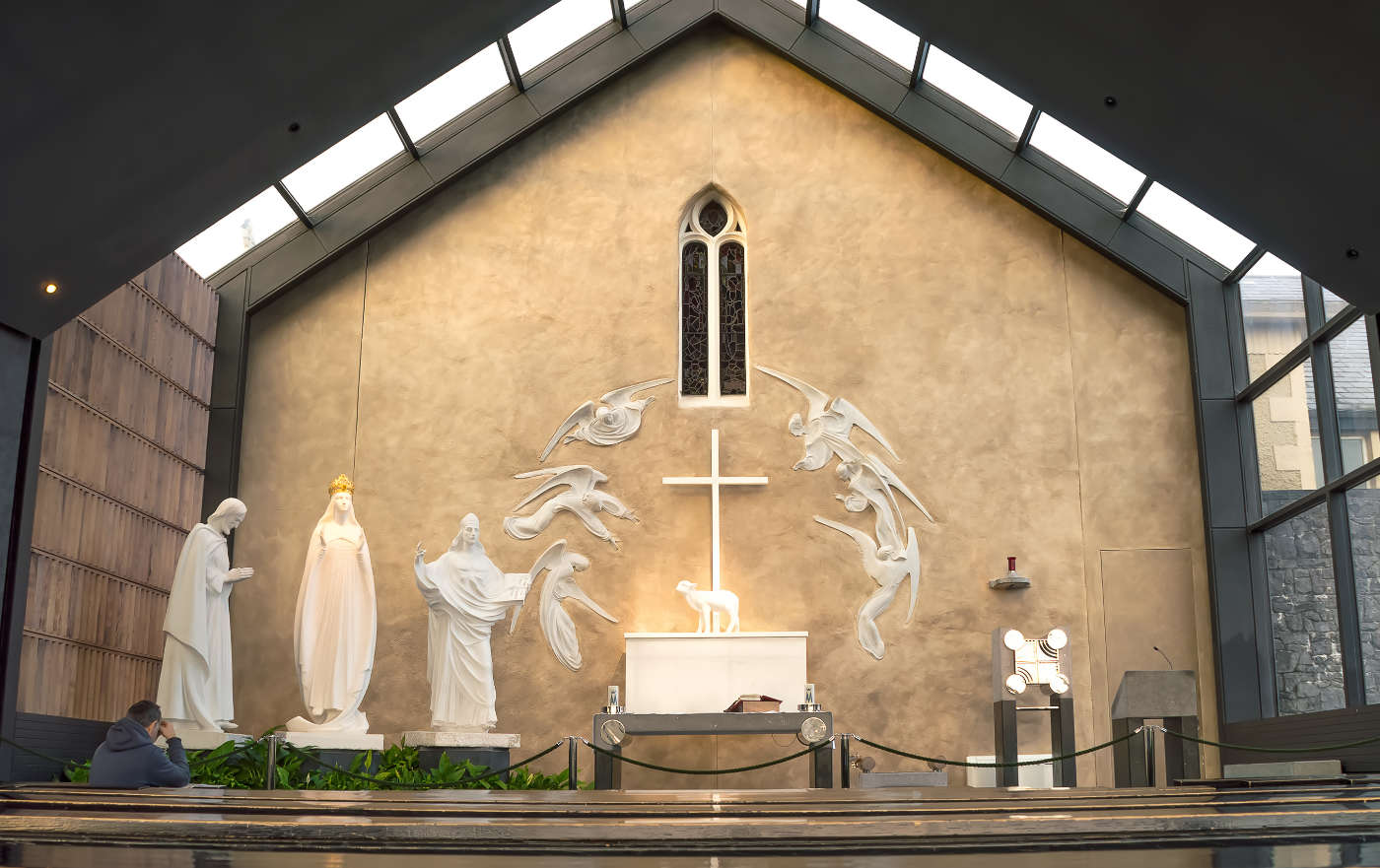
Apparition Scene on the original Gable of the Church
The Apparition
The Apparition may be easily re-constructed from the accounts of the various witnesses. The central figure, holding prominence of position, slightly in advance of the others, and somewhat taller in appearance, was recognized as our blessed Lady. " I was so taken up with the blessed Virgin," remarks one of the witnesses, that I did not pay much attention to the others." But there were others; and they were seen. As the witnesses looked, they saw to the left of our Lady, and inclined before Her, one whom they had no difficulty in identifying as St. Joseph; actually He was on the right. On Her left there was a figure clothed in priestly vestments with whom there was a little difficulty. But one of the witnesses identified the figure as that of Saint John the Evangelist. The only way in which she could do this, on her own avowal, was by a comparison with a statue of him already seen. But there was a difference; she noted it. The person in the Apparition wore a mitre, not the usual kind but a short-set kind of one which we know to be the characteristic of the Eastern Church. She it was who whispered that it was Saint John; the others were satisfied that it could only be he.
From the Apparition a mysterious light seemed to emanate, sparkling at various points like diamonds, and flowing out from the figures to extend itself almost to the height and width of the gable. But it was a soft light, though bright, and it was silvery. It was such a light as held the attention without strain. It could easily have escaped the notice of chance-on-lookers from the houses of the village which were faced away from the gable of the church. But it did happen, on that night, that a farmer in the distance, about half a mile away from the scene, went out to have a look at his land. He saw something that attracted his attention; he described what he saw as a large globe of golden light. " I never saw, I thought," he tells us, " so brilliant a light before; it appeared high up, above and around, the gable, and it was circular in appearance." In this way a fifteenth witness was drawn into the circle. He would testify, as an independent witness, to what the little group were now gazing at, with different emotions, each attracted by some different aspect of their common apparition.
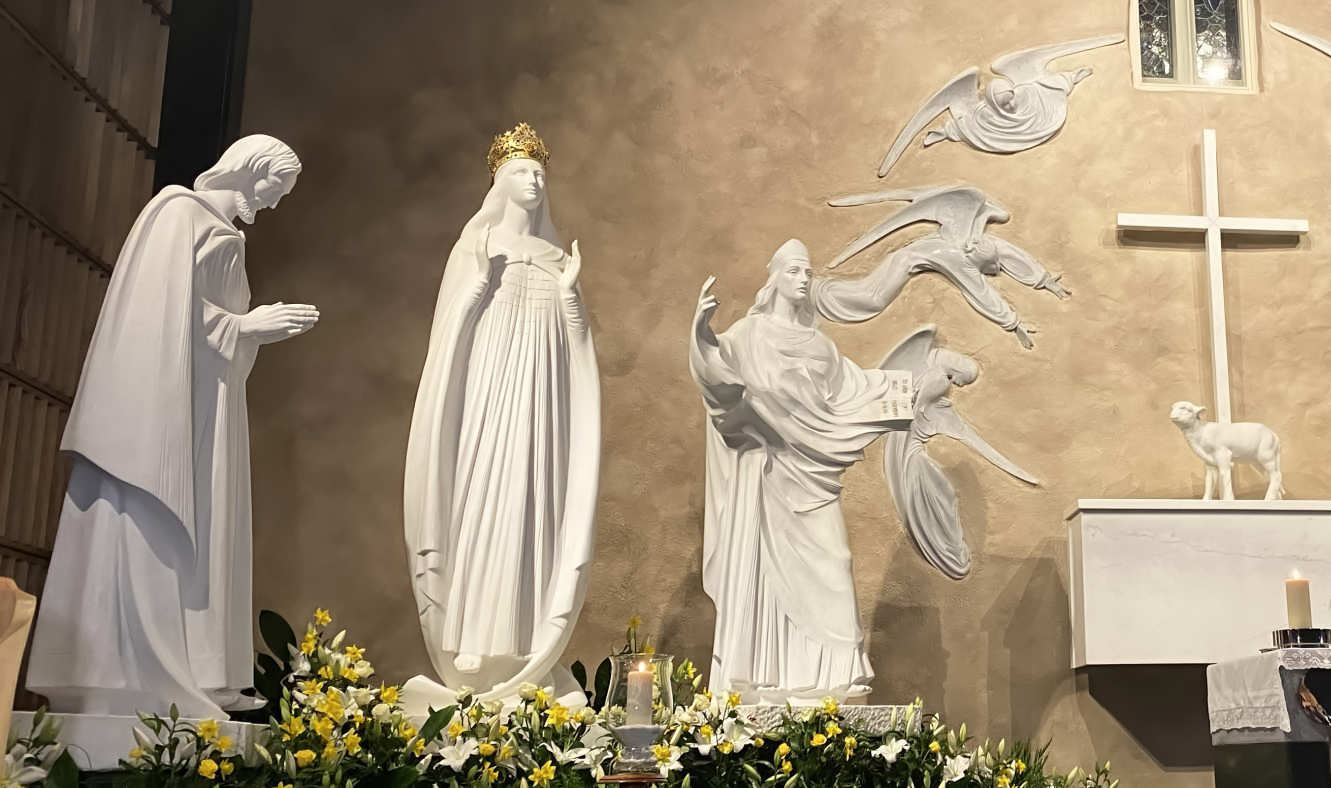
Apparition Scene Close Up
Full-Sized Altar
To the left of St. John and somewhat behind him there was an altar, a full-sized altar without ornaments of any kind, and upon the altar stood a lamb of some five or six weeks old; behind the lamb and away from him, standing erect upon the altar, was a large cross without any figures on it. The lamb seemed to be looking towards our Lady. But one witness, a little boy, saw that the lamb was surrounded by angels whose wings, he said, were fluttering, though he could not see their faces because they were not turned towards him. The lamb seemed to be radiating light; around him this witness saw what he described as a " halo of stars "; glittering jets of light seemed to be shooting out from his body; the lamb, he said, seemed to be " reflecting light ".
Between this altar and our Lady stood the Evangelist, St. John, whose right hand was raised and inclined in the direction of our blessed Lady; in his left hand he held a book "the lines and letters" of which the little boy saw; and he seemed to be preaching and impressing something upon the audience.
Everything in the apparition points to the fact that our blessed Lady is the central figure. She seems to be its very focus. But her attitude as they saw it was striking. Her hands were raised to the height of the shoulders; the palms of them were facing inwards and inclined towards Her breast; Her eyes were looking heavenwards. So minutely did the little boy observe things that he could describe, in his own way, the parts of Her eyes in detail. She wore white robes, fastened at the neck, and there was a golden crown upon Her head, a crown that seemed high, the upper parts of it being alive with sparkling crosses; immediately beneath the crown, where it fitted Her brow, was a rose. The atmosphere of the scene was one of stillness not incompatible with a gentle movement as the apparition seemed to advance and recede before their eyes. There was just enough to show that it was no tableau or static picture that they were contemplating. The spontaneous gesture of the old woman of seventy-five was to throw herself at the feet of our Lady to embrace them. But her sense of touch was not gratified. She returned to her place: "I continued to recite the rosary on my beads while there, and I felt great delight and pleasure in looking at the blessed Virgin. I could think of nothing else...". Such is the true account of that memorable evening of August 21st, 1879, when some fifteen people or more were privileged to find themselves in presence of our Lady of Knock.
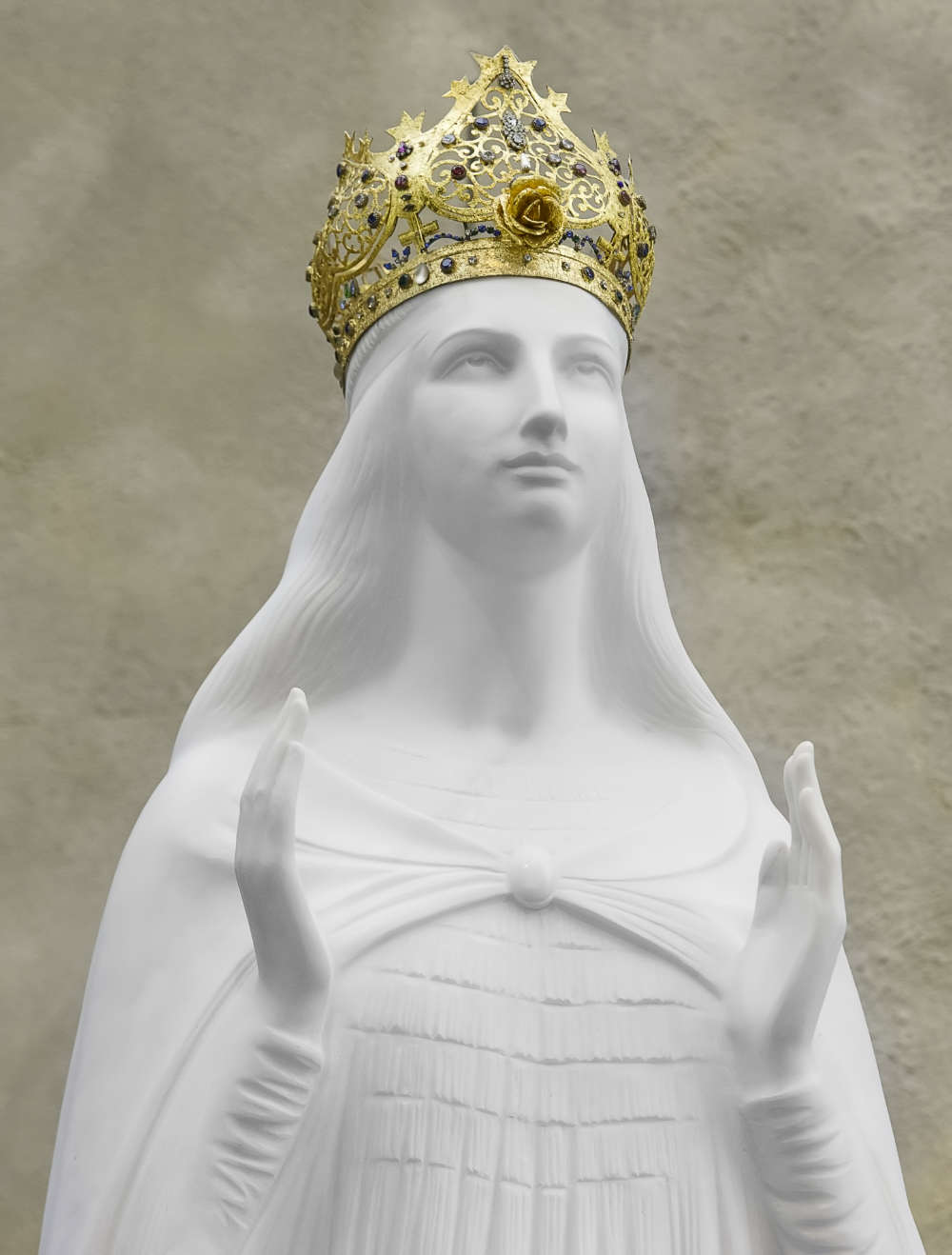
Our Lady of Knock
Symbolism of Knock
Our blessed Lady spoke at La Salette; She told the children to make known Her wishes; and at Lourdes She gave a verbal message; but at Knock She did not speak. Here is the ultimate objection, the one that has exercised the minds of many, and it is kept alive by the continued silence, the enigma of Knock. It matters little, for those who are arrested by it, that it was never the intention of our blessed Lady to add to that revelation committed to the Church or that when all Her precious words have been carefully gathered up they resolve themselves into the two great words of Prayer and Penance which She has constantly mentioned in Her apparitions. The fact remains that at La Salette She spoke and that at Lourdes She gave a verbal message; but at Knock She spoke not. Those who repeat this difficulty, and who are not stunned by the majestic silence of Knock, forget one very simple thing. Language is a means of communication; it is made up of sounds that are bearers of a spiritual meaning; and it is perfectly adapted to the material world of space and time. But there are times, even in this world of space and time, when language fails us; and silence is our only adequate means of communication.
Communication is the central thing in language; but there are different kinds of communication; and this is particularly true of communications received from a sphere that is beyond space and time. Amongst the witnesses at Knock there was the old woman of seventy-five who, with naive enthusiasm, endeavored to kiss the feet of our blessed Lady. She was frustrated in Her attempt. But was She entirely disappointed? She received from the Queen of Heaven a communication in the delight She experienced in simply looking at Her. One is reminded of the Catholic poet who went into a wayside church simply to gaze:
To say nothing, to gaze upon your face To let the heart sing in its own speech.
The poor Irish woman, for whose faith the invisible world was as real as the things around Her, wanted perhaps to feel the very touch of Her Lady's feet. The gesture was a natural one. But it was not the first time in history that the sense of touch has been denied. On the morrow of the Resurrection the risen Saviour, wishing to take the Magdalene's sense of His presence beyond the senses into a higher realm, simply said: "Do not touch Me." The injunction has never been forgotten by souls of great spiritual insight.
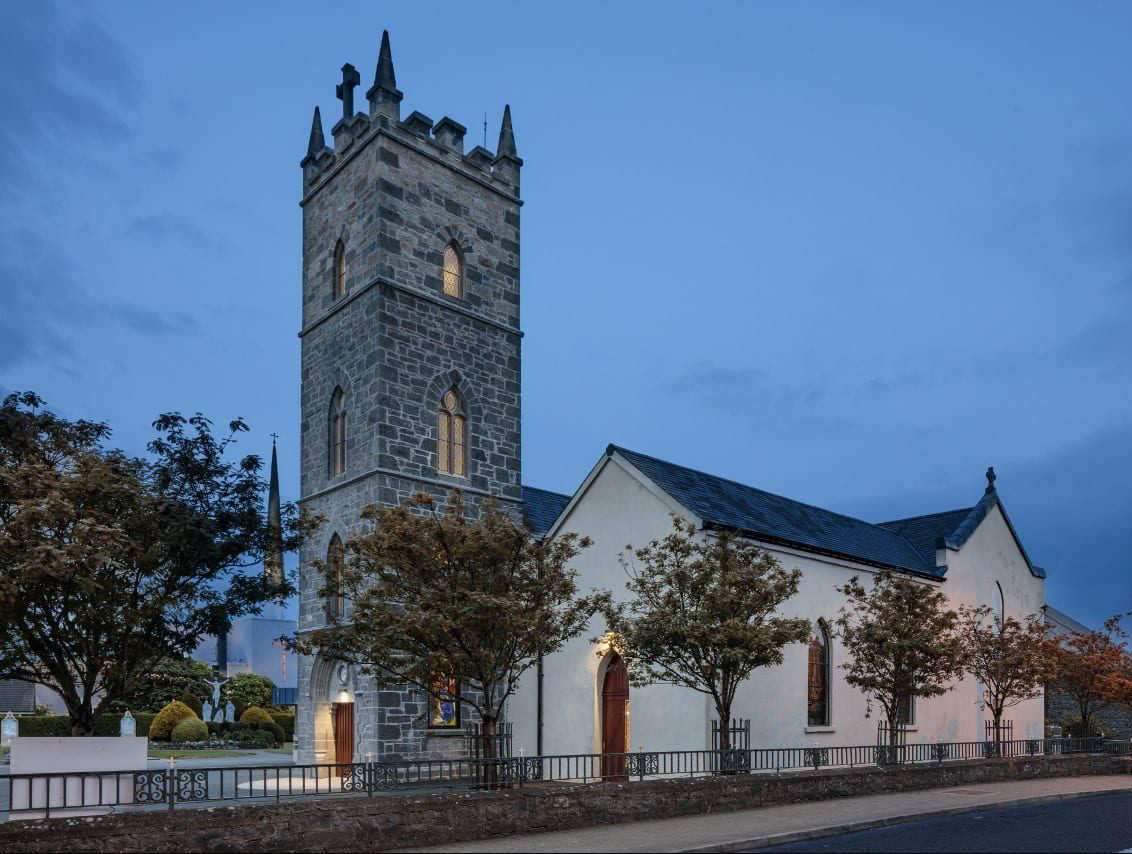
The Original Church of Knock with the Gable on the Back Side
Messages By Signs
It is essential, therefore, to distinguish between a verbal message, communicated by words, and a message that may be communicated in other ways. It must also be noted, where verbal messages themselves are concerned, that the popular notion of the speech of our Lady is entirely inadequate. Many good people imagine that when the blessed Virgin spoke, as She is reported to have done in the various apparitions, Her words must have fallen, like any other words, upon the external ear. But it is at least remarkable that people standing quite as close to our Lady as Her privileged seers were quite unable to hear. What is even more remarkable is that the verbal messages at La Salette and Lourdes were not received in the way in which ordinary verbal messages are heard. Few people advert to this, but it is true. When the shepherd of La Salette was asked whether the sounds of our Lady's voice made an impression on his ears, he replied that he knew not how to express it; but that the Lady's voice seemed to strike his heart rather than the drum of his ear. A similar question was put to St. Bernadette concerning the secrets She had received. But She had no hesitation in saying that the secrets could not have been heard by others because, as She explained, it was not like we are talking now. " When the blessed Virgin entrusted me with Her secrets She spoke to me here (pointing to Her heart) and not through the ear." It is lawful to infer, even when our Lady elects to speak, it is to the heart She addresses herself; and it is in the heart She must be heard. Language is, on past analysis, made up of signs. But at Knock the apparition is itself the sign; the very silence speaks.
When a message is too great for words, and its import too significant to be limited to the language of any single people, there is left the language of Catholicity in the silence of the apparition. The apparition itself speaks, the symbolism of Knock is shattering, and it is an apparition and a symbolism such that no human artist, much less fifteen people of the countryside, could have brought together in the unity of a single design. The artistry is that of Mary. She would have us see, in the apocalypse of Knock, the eternal issue of that struggle which is the crisis within every other crisis that takes place in time. There are many who do not even know in what that crisis consists; and that is part of the tragedy of the present situation. But it is nothing less than the eternal struggle of the archenemy of mankind for the possession, body and mind and spirit, of a humanity that belongs to Mary. This country cannot say that it has not been warned or that the Queen of Ireland has not given the sign of Her presence.
There is one obvious reason why our blessed Lady did not speak, in the ordinary way, at Knock. In the eyes of all these humble witnesses She manifested herself as one in prayer. There was about Her the stillness of that contemplative vision, the symbol of which was the mystical rose upon Her brow, as She stood there in all Her beauty interceding before the Throne of God. Remember that the liturgy of the Church in time is an extension of the liturgy of heaven and realize that the Gospel of the Assumption, read throughout the Octave, was the one in which it is said that Mary has chosen " the best part." The reference is to the scene in the Gospel when another Mary sat at the Master's feet while Martha busied herself about many things. But the significance of that scene as explained by St. Augustine is that Martha represents the Church militant on earth while Mary represents the Church triumphant in heaven. But our blessed Lady is the Church in person. She is crowned because, before Her Assumption, She had submitted to that death by which She shared in the redemption of mankind. It was not because of Her own sins She died; She had none. It was precisely for the sake of that humanity for which the Saviour Himself had laid His life. Hence She is crowned Queen, Queen of the Church in heaven and on earth.
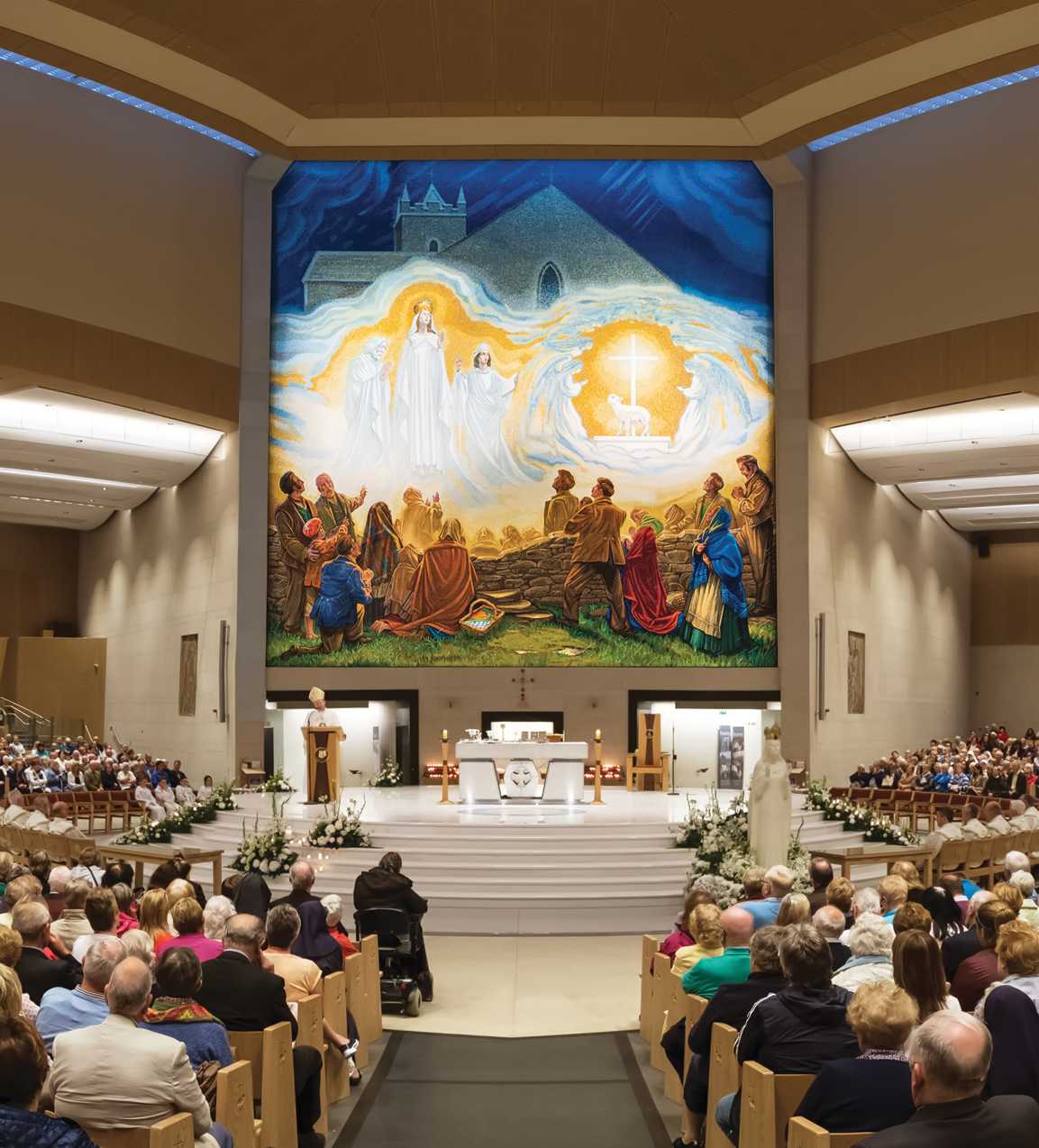
Basilica of Knock with Altar Picture
Patron Of The Church
If we look for a moment at the apparition we find, on the right hand of our Lady, the Spouse and Guardian of Her virginity, St. Joseph. Remember it is the year 1879. Only seven years before, at a moment when the Church seemed in the greatest peril, Pope Pius IX had declared St. Joseph Patron of the Universal Church. He is now seen at Knock. He is inclined before His Queen in the knowledge that all that He is and all that He has He owes to Her with whom, in life, He was united by God himself. Saint Joseph does not speak. He is the man of silence. But the whole attitude of reverence speaks and tells us of the meditation of our blessed Lady for that Church of which He has been declared the Patron and Protector. It is inevitable that the glory of this man, whose silence we have taken all too literally, should increase and extend as that of Mary is emphasized. St. Joseph is a great Saint. No other Saint in heaven has approached so closely to the dignity of the Queen of heaven as St. Joseph did; He occupies a place apart above and beyond the body of the Church, and this gives to Him a power of influence and intercession unequaled by others.
So much might be said, in presence of the apparition, that the subject is inexhaustible. But if we wish to find the message of Knock, while awaiting the authentic interpretation of the Church, we must approach St. John. To Him, in life, was Mary committed by Her dying Son; from Mary he learned much. But St. John, Bishop, is the official preacher and that is how the simple people of Knock beheld him. He seemed, they said, to be impressing something forcibly upon an audience. Our blessed Lady was included in his sermon. Now that message has been committed to writing. Therefore he held a book in his hands. But if you would find the message of Knock you must open the Apocalypse. It is a mighty book. It is, for very many, a sealed book. But it is the book that contains the key to universal history. Running through it, like a streak of flashing light, is the great theme of redemption in its three cosmic stages. There is, first, the mystery of "the Lamb which was slain from the beginning of the world." That is how St. John describes, in the thirteenth chapter, the eternal plan of redemption so simply and touchingly symbolized by the lamb of five or six weeks old that was seen at Knock. There is, secondly, the mystery of the woman "clothed with the sun" that is seen in travail on the earth where the mind of the seer of Patmos passes naturally from the Virgin-Mother to the suffering Church on earth of which She is the prototype. There is, finally, the City of God of which it is said that it has the glory of God and that the Lamb is the light thereof.
This is the City of God of which St. John has said: "And he showed me the holy city... coming down out of heaven from God. Having the glory of God." It is the city whose ensign is the Cross standing behind the Lamb as the instrument by which salvation was wrought and by which judgment will finally be passed upon the world. A glimpse of its splendor, through the eyes of their Queen was given at Knock. To the people of that time, emerging out of a dark night when they had proved their fidelity to the Mass, the sacrifice of Redemption, it was given as a consolation and the poor old woman who expressed her gratitude was the voice of Ireland. But to the people of the present time, confronted with a new menace, the apparition at Knock is a challenge. It is no longer a question of offering the sacrifice of Redemption upon a bare rock, without the externals of religion, but of extending this very sacrifice of Redemption into lives that are fully and militantly Catholic. Catholic in the true balance of prayer and action, of contemplation and apostolate; Catholic in their social as well as their individual activities. To be worthy of the faith of our Fathers, and of the Queen of heaven who has come to us, Knock must become a school where we shall learn the secret of true sanctity; then we shall go forth from it in the secure and conscious protection of Mary who is Queen of the Church on earth as She is Queen of the Church in heaven.
❤ In Sinu Jesu ❤
When Heart Speaks to Heart
The Journal of a Priest at Prayer
In 2007, Our Lord and Our Lady began to speak to the heart of a priest who was greatly in need of Their intervention—something that could truthfully be said of all of us in our spiritual poverty. The priest was prompted to write down what he heard, first and most obviously for his own benefit, but increasingly, for the benefit of others who would be touched by these words and find light and strength in them.
These messages were published in 2016 as a book entitled “In Sinu Jesu”.
This Book is a remarkable testament of a friendship that transcends all earthly measures. In its pages, we see the Hound of Heaven pursuing a priest with the exquisite gentleness of one who would win his heart’s love, the inexorable purpose of one who would show him mercy, and the compassion of one who would bring healing and peace.
Here is a message from this book of Our Lady about the Apparition of Knock.
Tuesday, February 5, 2008
At the Shrine of Our Lady of Knock, Ireland

I desire, My dear son, that Knock should become a place of pilgrimage for priests. I will make of Knock a place of healing for My priest sons. I will restore them to purity and to holiness of life. I will draw them into My company. I will give them a share in the sacred intimacy with Me that was the allotted portion of Saint Joseph, My most chaste spouse, and of Saint John, My adopted son. Here at Knock I want to reveal myself to priests as Virgin Bride and Mother. This is a secret that I have held in My heart for this time of trial for the Church. To every priest who desires it and asks Me for it, I will give the grace of living in My presence as Virgin Bride—this was the vocation given to Saint Joseph—and of living in My presence as Mother—this was the vocation given to Saint John when, from the Cross, My Son entrusted Me to him, and him to Me.
I want priests to begin to come to Knock. I want them to come with their bishops. The desire of My merciful and Immaculate Heart is that Knock should become a wellspring of purity, holiness, and renewal for all priests, beginning with those of Ireland. I have waited until now to reveal this project of My Heart. The time is short. Let priests come to Me here at Knock. I wait for them as Virgin Bride and as Mother. Let them come to wash themselves in the Blood of the Lamb, My Son, and to be united to Him, Priest and Victim, in the Mystery of His Sacrifice. Knock is for all My people, but it was, from the beginning, destined to be a place of healing and of abundant graces for priests. Let this be made known to the bishops and priests of My Church.
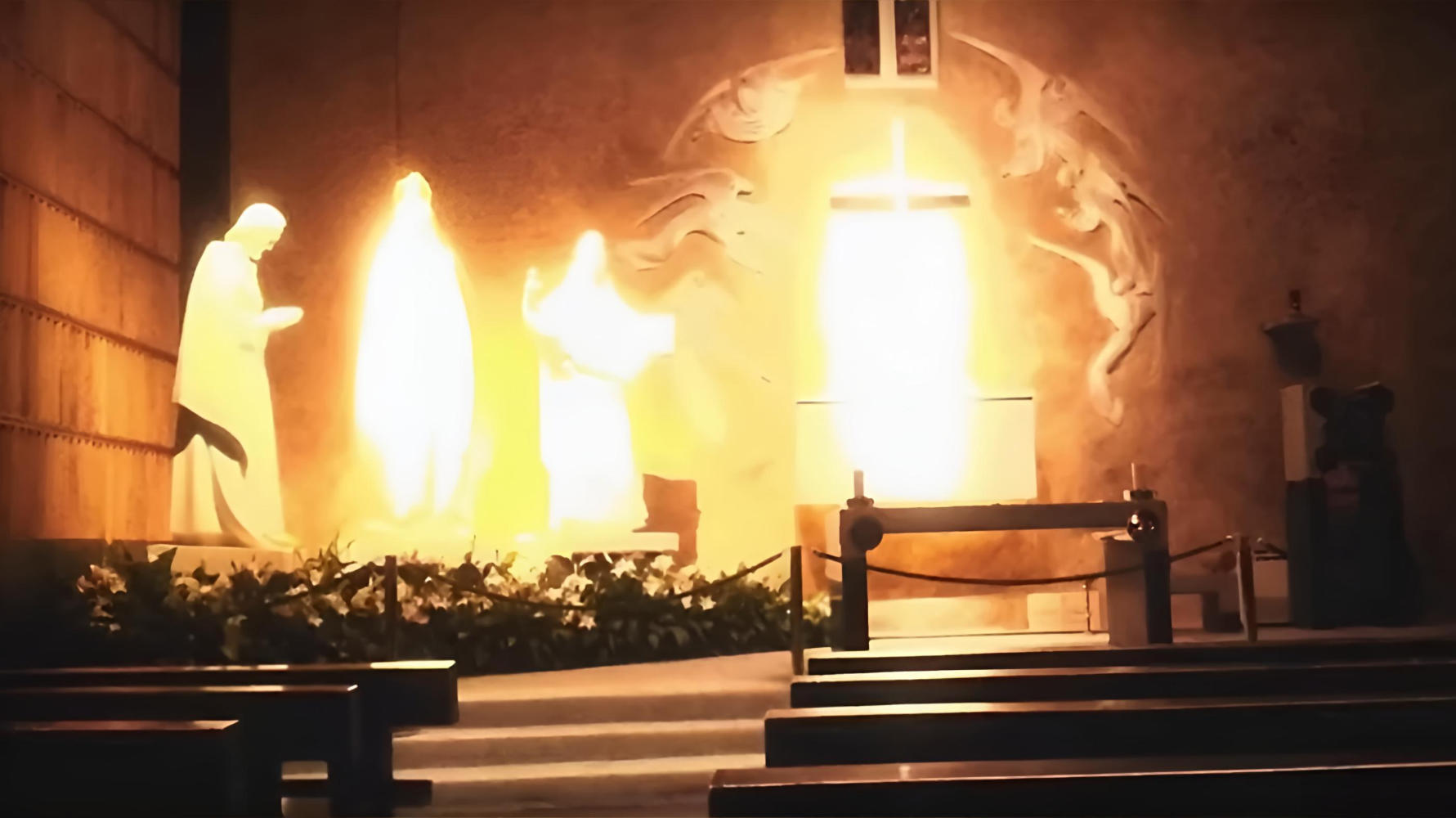
A picture taken by a pilgrim miraculously appeared on his smartphone
I long to be the Virgin Bride and Mother of all priests. In sacred intimacy with Me they will find the holiness that My Son desires to give each of them: a radiant holiness, a holiness that will illumine the Church in these last days with the brightness of the Lamb. Let them come here to remain in adoration before My Son, the Lamb Who was slain. Let them wash themselves in His precious Blood by seeking absolution from all their sins. Let them entrust and consecrate themselves to Me as Virgin Bride and Mother. Almighty God will do great things in them and through them. I so desire that Knock should become for all priests a fountain of living water, a place of healing, of comfort, and of renewal. My hands are ever raised in supplication for My priest sons, and My Heart is ready to receive them here.
Let them come to Me and I will manifest myself to each one as the Mediatrix of all graces and as the helper given them by God in their priestly ministry. I am the New Eve given to the New Adam—and given by Him from the Cross to all His priests, to those called by Him to continue His mission of salvation in the world. I, the Lady of Knock, am the Virgin Bride and Mother of all priests. Let them come to Me and, in the company of Saint Joseph and Saint John, taste of My sweetness.
It is for this reason that I brought you here. I want you to be the first to consecrate yourself to Me as Virgin Bride and Mother. I want you to model your own life after that of Saint Joseph and Saint John. Live in My sacred intimacy. Share all things with Me. There is no need for you or any priest to remain alone. My Heart is open to all My priest sons, and to those who ask for it, I will not refuse the grace of a special intimacy with Me, a participation in the unique grace given Saint Joseph and Saint John in the beginning. This was the grace that I gave Archdeacon Cavanagh in this very place. From his place with Me in heaven, he intercedes for the priests of Ireland and for all priests. And now we bless you, in the Name of the Father, and of the Son, and of the Holy Spirit. Amen.
Apparitions of Jesus and Mary
The Apparition of Our Lady at Caravaggio
The Apparitions of Our Lady of the Good Event at Quito
The Revelations to Saint Margarete Mary Alacoque
The Apparitions of Our Lady at La Salette
The Apparations of Our Lady at Lourdes
The Apparition of Our Lady at Pontmain
The Apparitions of Our Lady at Pellevoisin
The Apparition of Our Lady at Knock
The Apparitions of Our Lady at Castelpetroso
The Apparations of Our Lady at Fatima
The Apparitions of Our Lord and Our Lady at Campinas
The Apparitions of Our Lady at Beauraing
The Apparitions of Our Lady at Heede
The Apparitions of Our Lady at Ghiaie di Bonate
The Apparitions of Rosa Mistica at Montichiari and Fontanelle
The Apparitions of Our Lady at Garabandal
The Apparitions of Our Lady at Medjugorje